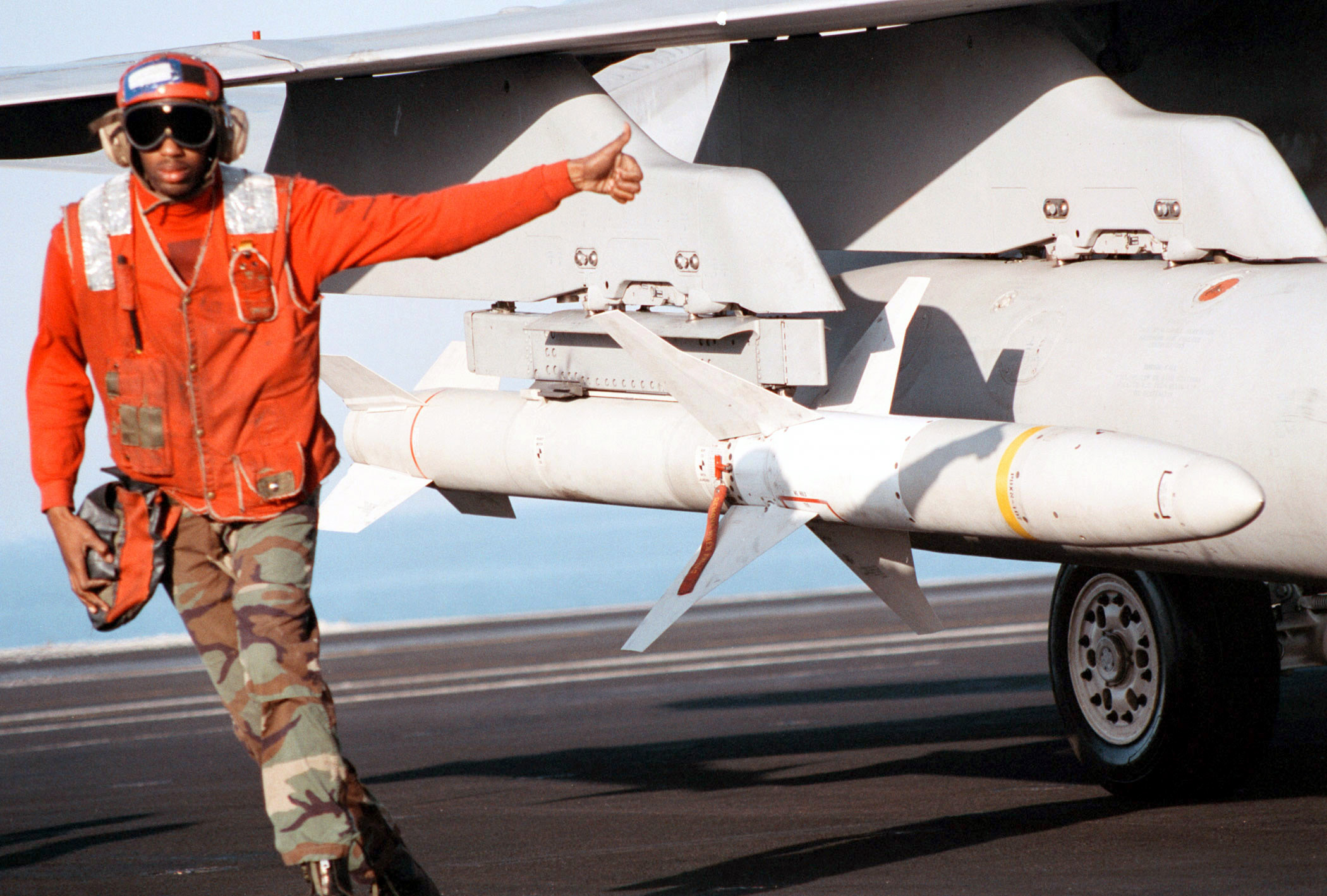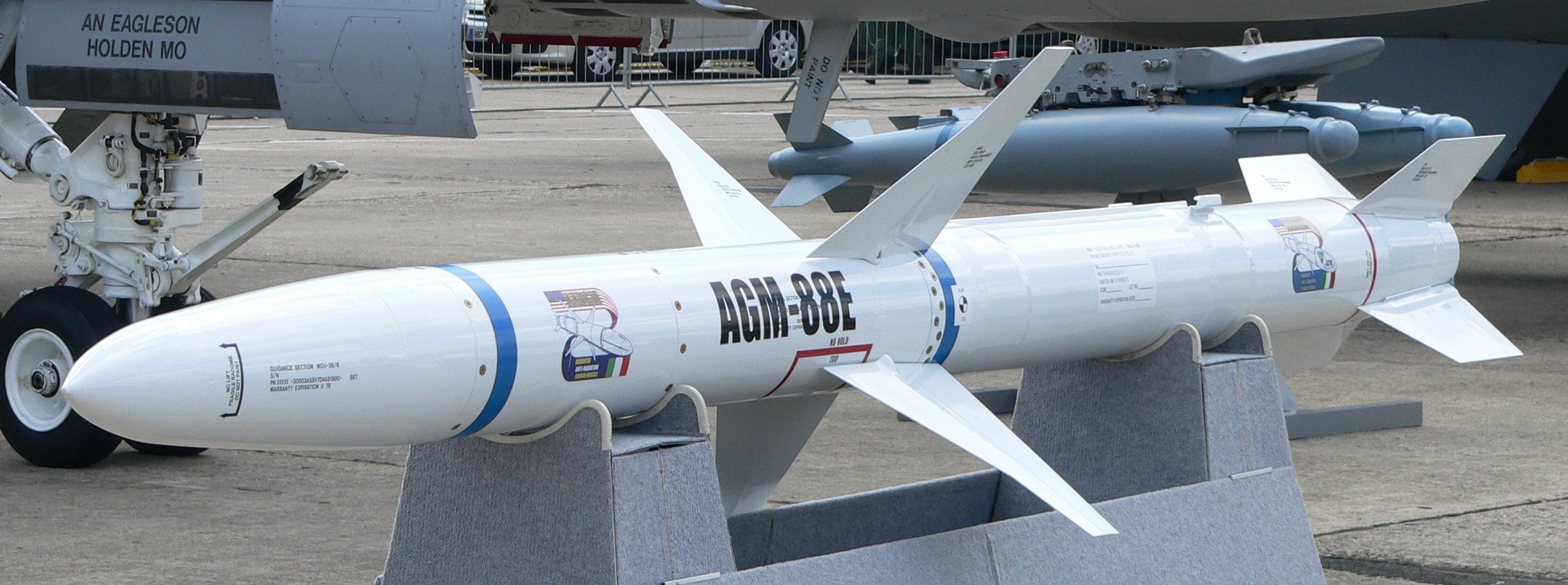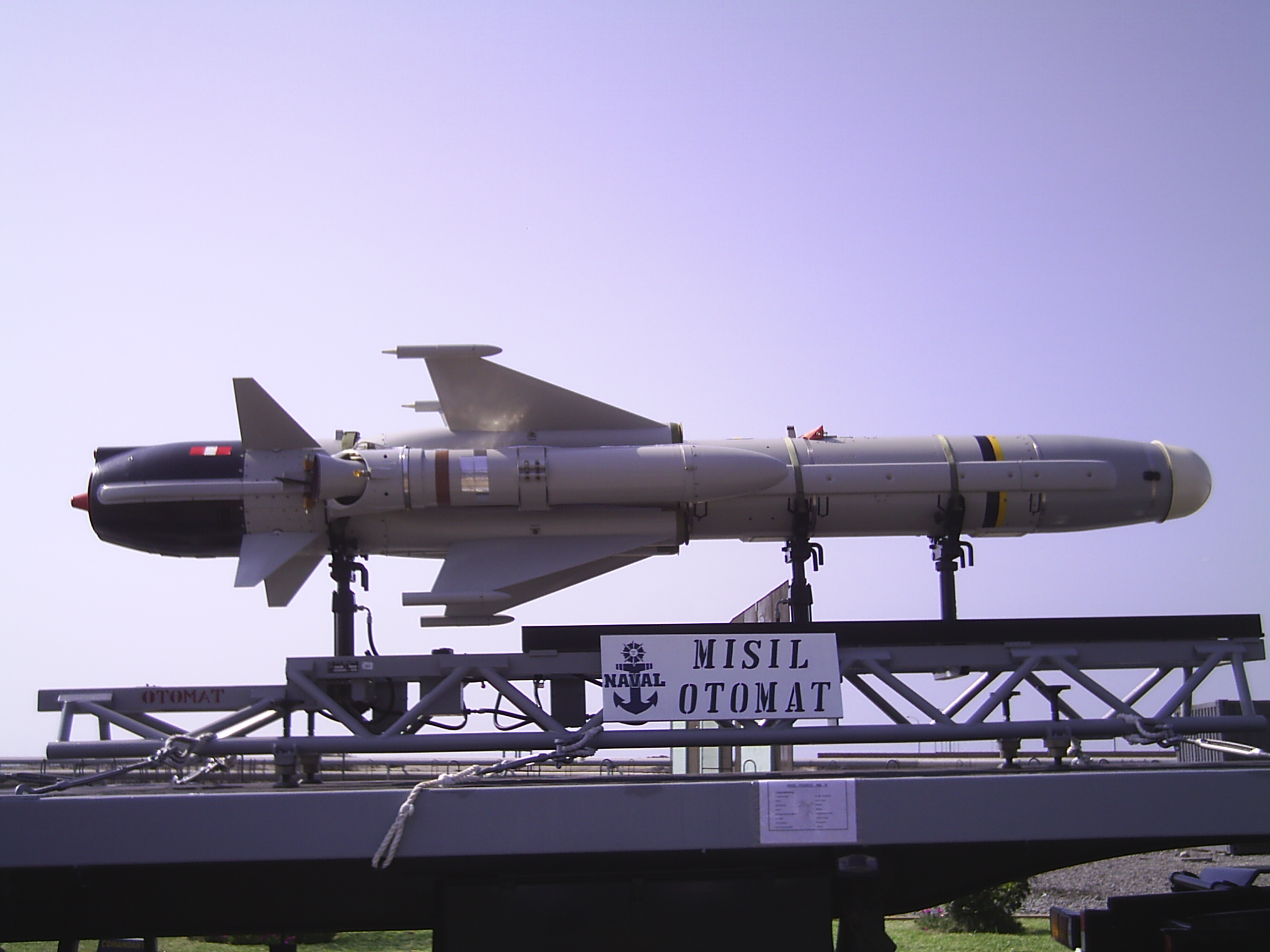|
Anti-radiation Missile
An anti-radiation missile (ARM) is a missile designed to detect and home in on an enemy radio emission source. Typically, these are designed for use against an enemy radar, although jammers and even radios used for communications can also be targeted in this manner. The earliest known anti-radiation weapon is a variant of the Blohm & Voss BV 246 radar guided bomb. Air-to-surface Most ARM designs to date have been intended for use against ground-based radars. Commonly carried by specialist aircraft in the Suppression of Enemy Air Defenses (SEAD) role (known to United States Air Force as "Wild Weasels"), the primary purpose of this type of missile is to degrade enemy air defenses in the first period of a conflict in order to increase the chance of survival for the following waves of strike aircraft. They can also be used to quickly shut down unexpected surface-to-air missile (SAM) sites during an air raid. Often, SEAD escort aircraft also carry cluster bombs, which can be u ... [...More Info...] [...Related Items...] OR: [Wikipedia] [Google] [Baidu] |
AGM-88 HARM On FA-18C
The AGM-88 HARM (High-speed Anti-Radiation Missile) is a tactical, air-to-surface anti-radiation missile designed to home in on electronic transmissions coming from surface-to-air radar systems. It was originally developed by Texas Instruments as a replacement for the AGM-45 Shrike and AGM-78 Standard ARM system. Production was later taken over by Raytheon Corporation when it purchased the defense production business of Texas Instruments. Description The AGM-88 can detect, attack and destroy a radar antenna or transmitter with minimal aircrew input. The proportional guidance system that homes in on enemy radar emissions has a fixed antenna and seeker head in the missile's nose. A smokeless, solid-propellant, booster-sustainer rocket motor propels the missile at speeds over Mach 2.0. The HARM was a missile program led by the U.S. Navy, and it was first carried by the A-6E, A-7, and F/A-18A/B aircraft, and then it equipped the EA-6B and EA-18G dedicated electronic attack aircraft ... [...More Info...] [...Related Items...] OR: [Wikipedia] [Google] [Baidu] |
Rudram (missile)
The Rudram (IAST: Rudram, meaning remover of sorrows) is a series of air-to-surface ground attack and anti-radiation missiles in development by the Defence Research and Development Organisation of India. It can be launched from a range of altitudes with large standoff distance for destroying enemy surveillance radars, communication stations and bunkers. It will be manufactured jointly by Bharat Dynamics Limited (BDL) and Bharat Electronics Limited (BEL) after trials and introduction. DRDO also involved Adani Defence and Aerospace under Development cum Production Partner programme for mass production. Description Defence Research and Development Laboratory (DRDL) is the primary agency which carried out the design and development of the missile system along with Armament Research and Development Establishment (ARDE), Defence Electronics Research Laboratory (DLRL), High Energy Materials Research Laboratory (HEMRL), Research Centre Imarat (RCI) and Terminal Ballistics Research ... [...More Info...] [...Related Items...] OR: [Wikipedia] [Google] [Baidu] |
Vietnam War
The Vietnam War (also known by #Names, other names) was a conflict in Vietnam, Laos, and Cambodia from 1 November 1955 to the fall of Saigon on 30 April 1975. It was the second of the Indochina Wars and was officially fought between North Vietnam and South Vietnam. The north was supported by the Soviet Union, China, and other communist states, while the south was United States in the Vietnam War, supported by the United States and other anti-communism, anti-communist Free World Military Forces, allies. The war is widely considered to be a Cold War-era proxy war. It lasted almost 20 years, with direct U.S. involvement ending in 1973. The conflict also spilled over into neighboring states, exacerbating the Laotian Civil War and the Cambodian Civil War, which ended with all three countries becoming communist states by 1975. After the French 1954 Geneva Conference, military withdrawal from Indochina in 1954 – following their defeat in the First Indochina War – the Viet Minh to ... [...More Info...] [...Related Items...] OR: [Wikipedia] [Google] [Baidu] |
Semi-active Radar Homing
Semi-active radar homing (SARH) is a common type of missile guidance system, perhaps the most common type for longer-range Air-to-air missile, air-to-air and surface-to-air missile systems. The name refers to the fact that the missile itself is only a passive radar, passive detector of a radar signal—Radar illumination, provided by an external ("offboard") source—as it reflects off the target (in contrast to active radar homing, which uses an active radar transceiver). Semi-active missile systems use bistatic radar, bistatic continuous-wave radar. The NATO Multiservice tactical brevity code, brevity code for a semi-active radar homing missile launch is Fox (code word), Fox One. Concept The basic concept of SARH is that since almost all detection and tracking systems consist of a radar system, duplicating this hardware on the missile itself is redundant. The weight of a transmitter reduces the range of any flying object, so passive systems have greater reach. In addition, t ... [...More Info...] [...Related Items...] OR: [Wikipedia] [Google] [Baidu] |
Active Radar Homing
Active radar homing (ARH) is a missile guidance method in which a missile contains a radar transceiver (in contrast to semi-active radar homing, which uses only a receiver) and the electronics necessary for it to find and track its target autonomously. The NATO brevity code for an air-to-air active radar homing missile launch is fox three. Advantages There are two major advantages to active radar homing: * As the missile is tracking the target it is going to be much closer to the target than the launching platform during the terminal phase, thus the missile's tracking can be much more accurate and better resistant to electronic countermeasures. Active radar homing missiles have some of the best kill probabilities, along with missiles employing track-via-missile guidance. * Because the missile is totally autonomous during the terminal phase, the launch platform does not need to have its radar enabled at all during this phase, and in the case of a mobile launching platform ... [...More Info...] [...Related Items...] OR: [Wikipedia] [Google] [Baidu] |
Otomat
The Otomat is an anti-ship and coastal defence missile developed by the Italian company Oto Melara jointly with Matra and now made by MBDA. The name comes, for the first versions, from the name of the two builders ("Oto Melara" and "Matra") and, for the later versions, Teseo, from the Italian word for Theseus. The MILAS variant is an anti-submarine missile. In its latest version Mk/2E purchased by the Italian Navy is a medium range anti-ship missile and a ground attack missile. Origins The Otomat missile program started in 1967, the same year in which the Israeli destroyer ''Eilat'' was sunk by three Soviet-made P-15 Termit anti-ship missiles. This event raised awareness about the effectiveness of such weapons and prompted the development of similar systems in Western countries, such as the Harpoon in the United States. However, it is unknown whether the Otomat program started before or after the Eilat event. The Otomat program was undertaken by the Italian Oto Melara corporat ... [...More Info...] [...Related Items...] OR: [Wikipedia] [Google] [Baidu] |
Exocet
The Exocet () is a French-built anti-ship missile whose various versions can be launched from surface vessels, submarines, helicopters and fixed-wing aircraft. Etymology The missile's name was given by M. Guillot, then the technical director at Nord Aviation. It is the French word for flying fish, from the Latin ''exocoetus'', a transliteration of the Greek name for the fish that sometimes flew into a boat: (''exōkoitos''), literally "lying down outside (, ), sleeping outside". Description The Exocet is built by MBDA, a European missile company. Development began in 1967 by Nord as a ship-launched weapon named the MM38. A few years later, Aerospatiale and Nord merged. The basic body design was based on the Nord AS-30 air-to-ground tactical missile. The sea-launched MM38 entered service in 1975, whilst the air-launched AM39 Exocet began development in 1974 and entered service with the French Navy five years later in 1979. The relatively compact missile is designed for at ... [...More Info...] [...Related Items...] OR: [Wikipedia] [Google] [Baidu] |
P-500 Bazalt
The P-500 ''Bazalt'' (russian: П-500 «Базальт»; en, basalt) is a turbojet-powered, supersonic cruise missile used by the Soviet and Russian navies. Its GRAU designation is 4K80 and its NATO reporting name is SS-N-12 ''Sandbox'', its upgraded version being the P-1000 Vulkan AShM SLCM. History Developed by OKB-52 MAP (later NPO Mashinostroyeniye), it entered service to replace the SS-N-3 Shaddock. The P-500 Bazalt was first deployed in 1975 on the , and was later added to both the and the s. A version of the P-500 Bazalt with improved guidance and engines is used on the s. The sixteen launchers dominate the decks of the class. Description The P-500 Bazalt has a 550 km range and a payload of 1,000 kg, which allows it to carry a 350 kt nuclear or a 950 kg semi-armor-piercing high-explosive warhead. The P-500 Bazalt uses active radar homing for terminal guidance, and can receive mid-course correction from the Tupolev Tu-95RTs Bear D, the Kamov Ka-25 ... [...More Info...] [...Related Items...] OR: [Wikipedia] [Google] [Baidu] |
P-700 Granit
The P-700 ''Granit'' (russian: П-700 "Гранит"; en, granite) is a Soviet and Russian naval anti-ship cruise missile. Its GRAU designation is 3M45, its NATO reporting name SS-N-19 ''Shipwreck''. It comes in surface-to-surface and submarine-launched variants, and can also be used against ground targets.Video: Russia’s Oscar-II SSN Tomsk launches cruise missile against coastal target - Navyrecognition.com, 13 July 2017 (erroneous citation) Design and building The P-700 was designed in the 1970s to replace the |
Surface-to-surface Missile
A surface-to-surface missile (SSM) or ground-to-ground missile (GGM) is a missile designed to be launched from the ground or the sea and strike targets on land or at sea. They may be fired from hand-held or vehicle mounted devices, from fixed installations, or from a ship. They are often powered by a rocket engine or sometimes fired by an explosive charge, since the launching platform is typically stationary or moving slowly. They usually have fins and/or wings for lift and stability, although hyper-velocity or short-ranged missiles may use body lift or fly a ballistic trajectory. The V-1 flying bomb The V-1 flying bomb (german: Vergeltungswaffe 1 "Vengeance Weapon 1") was an early cruise missile. Its official Ministry of Aviation (Nazi Germany), Reich Aviation Ministry () designation was Fi 103. It was also known to the Allies as the buz ... was the first operational surface-to-surface missile. Contemporary surface-to-surface missiles are usually guided missile, guided. An ... [...More Info...] [...Related Items...] OR: [Wikipedia] [Google] [Baidu] |
MAR-1
The MAR-1 is an air-to-surface (ASM) and surface-to-surface (SSM) anti-radiation missile (ARM) with GPS/INS capability under development by Brazil's Mectron and the Aerospace Technology and Science Department (Departamento de Ciência e Tecnologia Aeroespacial, DCTA) of the Brazilian Air Force. It is designed to suppress enemy air defenses ( SEAD) by targeting surveillance radars and fire-control radars. Development and design Development began in 1997 and was kept under tight secrecy, and for many years the weapon's manufacturers refused to acknowledge its existence. The program was conducted since the beginning by DCTA (Aerospace Technology and Science Department), along with Mectron, a São José dos Campos based company, and is currently in final testing phase. According to FAB, the test campaign is now in the weapons separation trials phase, using A-1B aircraft from IPTV (Instituto de Pesquisa e Teste de Voo - Research and Flight Test Institute), a division of DCTA. C ... [...More Info...] [...Related Items...] OR: [Wikipedia] [Google] [Baidu] |
Brazilian Air Force
"Wings that protect the country" , colours = , colours_label = , march = Hino dos Aviadores , mascot = , anniversaries = 22 May (anniversary) 22 April (fighter aviation day) , equipment = , equipment_label = , battles = Contestado War Lieutenants RevoltsConstitutionalist WarWorld War II Lobster WarTrês Passos GuerrillaCaparaó Guerrilla Araguaia Guerrilla WarOperation Traira , decorations = , battle_honours = , battle_honours_label = , flying_hours = , website = , commander1 = President Lula da Silva , commander1_label = Commander-in-Chief , commander2 = Paulo Sérgio Nogueira de Oliveira , commander2_label = Minister of Defence , commander3 = Carlos d ... [...More Info...] [...Related Items...] OR: [Wikipedia] [Google] [Baidu] |








